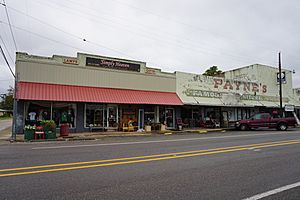Caddo Mills, Texas facts for kids
Quick facts for kids
Caddo Mills, Texas
|
|
|---|---|

Main Street in Caddo Mills
|
|
| Country | United States |
| State | Texas |
| County | Hunt |
| Area | |
| • Total | 4.22 sq mi (10.94 km2) |
| • Land | 4.21 sq mi (10.92 km2) |
| • Water | 0.01 sq mi (0.02 km2) |
| Elevation | 495 ft (151 m) |
| Population
(2020)
|
|
| • Total | 1,495 |
| • Density | 354.3/sq mi (136.65/km2) |
| Time zone | UTC-6 (Central (CST)) |
| • Summer (DST) | UTC-5 (CDT) |
| ZIP code |
75135
|
| Area code(s) | 903, 430 |
| FIPS code | 48-11716 |
| GNIS feature ID | 2409954 |
Caddo Mills is a small city in Hunt County, Texas. It is located in the western part of Northeast Texas. In 2020, about 1,495 people lived there. This was more than the 1,338 people who lived there in 2010.
Contents
The Story of Caddo Mills
Long ago, the area where Caddo Mills is now was a campground for the Caddo people. Pioneers, who were early settlers, arrived in the late 1850s.
About 20 years later, two men named I.T. Johnson and Henry King built a gristmill. A gristmill is a place where grain is ground into flour. People started calling the community "Caddo Mills" because of this mill.
On June 16, 1879, a post office opened in the town. Around that time, about 100 people lived there. There were also three churches and a school.
In 1886, the Missouri, Kansas and Texas Railway built train tracks through Caddo Mills. This helped the town grow, and the population increased to 500 people. In the late 1800s and early 1900s, Caddo Mills got a newspaper and a bank. The population reached 790, but it started to get smaller in the 1920s. Caddo Mills officially became a city in the early 1940s. At that time, it had 390 residents and 20 businesses.
Where is Caddo Mills?
Caddo Mills is located in Northeast Texas. It is on the western edge of Hunt County. Texas State Highway 66 goes right through the middle of the city.
This highway leads northeast about 9 miles (14 km) to Greenville. Greenville is the main city in Hunt County. The highway also goes southwest about 9 miles (14 km) to Royse City.
Downtown Dallas is about 41 miles (66 km) southwest of Caddo Mills. Sulphur Springs is about 36 miles (58 km) northeast.
The city covers a total area of about 4.22 square miles (10.9 km²). Only a very small part of this area, about 0.01 square miles (0.02 km²), is covered by water. West Caddo Creek flows through the southwestern part of the city. This creek is part of the Sabine River system.
How Many People Live Here?
The number of people living in Caddo Mills has changed over the years:
| Historical population | |||
|---|---|---|---|
| Census | Pop. | %± | |
| 1940 | 390 | — | |
| 1950 | 509 | 30.5% | |
| 1960 | 732 | 43.8% | |
| 1970 | 935 | 27.7% | |
| 1980 | 1,060 | 13.4% | |
| 1990 | 1,068 | 0.8% | |
| 2000 | 1,149 | 7.6% | |
| 2010 | 1,338 | 16.4% | |
| 2020 | 1,495 | 11.7% | |
| 2023 (est.) | 4,183 | 212.6% | |
| U.S. Decennial Census | |||
In 2020, the 2020 United States census counted 1,495 people living in Caddo Mills. There were 583 households and 435 families.
Who Lives in Caddo Mills?
Here is a look at the different groups of people living in Caddo Mills in 2020:
| Race | Number | Percentage |
|---|---|---|
| White (NH) | 1,197 | 80.07% |
| Black or African American (NH) | 47 | 3.14% |
| Native American or Alaska Native (NH) | 7 | 0.47% |
| Asian (NH) | 2 | 0.13% |
| Some Other Race (NH) | 4 | 0.27% |
| Mixed/Multi-Racial (NH) | 50 | 3.34% |
| Hispanic or Latino | 188 | 12.58% |
| Total | 1,495 |
Schools in Caddo Mills
Students in Caddo Mills attend schools in the Caddo Mills Independent School District.
Getting Around Caddo Mills
There are several ways to travel in and around Caddo Mills.
Major Roads
 Interstate 30
Interstate 30 U.S. Highway 67 (runs along Interstate 30)
U.S. Highway 67 (runs along Interstate 30) State Highway 66
State Highway 66
Smaller Roads
Air Travel
Caddo Mills has its own airport called the Caddo Mills Municipal Airport. This airport offers services for smaller planes, known as general aviation.
Train Travel
The city is served by the Dallas, Garland and Northeastern Railroad. This railroad uses the old train tracks that were built by the MK&T company. Today, these tracks are only used for carrying goods, not for passengers.
Famous People from Caddo Mills
- Guy Benton Johnson, a well-known sociologist (someone who studies human society).
See also
 In Spanish: Caddo Mills para niños
In Spanish: Caddo Mills para niños

